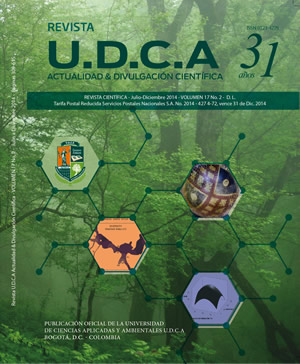Comparison of thyroid profile in domestic cat by gender
Comparación del perfil tiroideo en el gato doméstico por género y edad
Main Article Content
Abstract
Serum levels of thyroid hormones in cats are analyzed to determine the normal range in the species, and, for identifying a possible alteration either at the level of the thyroid gland or pituitary level, resulting in a high or low concentration of them. The objective of the present research was to compare and analyze the correlation between serum thyroid concentrations of four groups native-born cats or their crosses (females young vs. males young, adult females vs. adult males, females young vs. adult females, males young vs. adult males). Samples from 96 cats in the fasting state, differentiated by gender and age (46 cats under one year: 21 females and 25 males and 46 cats over one year: 21 females and 25 males) were obtained, and the levels of thyroid releasing hormone (TSH) and free tetraiodothyronine (T4L) were measured by enzymatic immunoassay. For the group of young cats statistically significant difference was found in the T4L variable with P value less than 0.05 (0.01) for a confidence of 95%, just as in group of females was found a statistically significant difference in this same variable with a P value less than 0.05 (0.03). The results shown by young females suggests high concentrations of thyroid profile with respect to young males and lower concentrations compared to adult females
Downloads
Publication Facts
Reviewer profiles N/A
Author statements
- Academic society
- Universidad de Ciencias Aplicadas UDCA
- Publisher
- Universidad de Ciencias Aplicadas y Ambientales U.D.C.A
Article Details
References (SEE)
ADAMS, W.H.; DANIEL, G.B.; LEGENDRE, A.M. 1997. Investigation of the effects of hyperthyroidism on renal function in the cat. Can. J. Vet.Res. 61:53-56.
ARCHER, F.J.; TAYLOR, S.M. 1996. Alkaline phosphatase bone isoenzyme and osteocalcin in the serum of hyperthyroid cats. Can. Vet. J. 37:735-739.
BIRCHARD, S.J. 2006. Thyroidectomy in the cat. Clin Tech Small Anim Pract. 21(1):29-33.
BORETTI, F.S.; SIEBER-RUCKSTUHL, N.A.; GERBER, B.; LALUHA, P.; BAUMGARTNER, C.C.; LUTZ, H. 2009. Thyroid enlargement and its relationship to clinicopathological parameters and T4 status in suspected hyperthyroid cats. J. Fel. Med. Surg. 11(4):286-292.
BRENNAN, S.F.; JONES, B.R. 2005. Feline hyperthyroidism. EJCAP. 15(2):169-172.
CUNNINGHAM, J.G.; KLEIN, B.G. 2009. Fisiología Veterinaria. 4ta ed. Barcelona, España: Elsevier Saunders. p. 430-436.
DEBORAH, S.; GRECO. 2006. Diagnosis of congenital and adult-onset hypothyroidism in cats. Clin Tech Small Anim Pract 21:40-44.
DE WET, C.S.; MOONEY, C.T.; THOMPSON, P.N.; SCHOEMAN, J.P. 2009. Prevalence of and risk factors for feline hyperthyroidism in Hong Kong. J Feline Med Surg. 11(4):315-321.
EDINBORO, C.H.; SCOTT-MONCRIEFF, J.C.; JANOVITZ, E.; THACKER, H.L.; GLICKMAN, L.T. 2004. Epidemiologic study of relationships between consumption of commercial canned food and risk of hyperthyroidism in cats. J. Am. Vet. Med. Assoc. 224(6):879-886.
FERGUSON, D.C.; CAFFALL, Z.; HOENIG, M. 2007. Obesity increases free thyroxine proportionally to nonesterified fatty acid concentrations in adult neutered female cats. J. Endocrin. 194(2):267-273.
GUNN-MOORE, D. 2005. Feline endocrinopathies. Vet Clin Small Anim. 35(1):171-210.
HOPTON, M.R.; HARRAP, J.J. 1986. Inmunoradiometric assay of thyrotropinas as a first line thyroid function test in the routine laboratory. Clin. Chem. 32:691-691.
KAPLAN, E. 2002. Primary hyperparathyroidism and concurrent hyperthyroidism in a cat. Can. Vet J. 43(2):117-119.
KRATZSCH, J.; PULZER, F. 2008. Thyroid gland development and defects. Best Practice Res. Clin. Endocrin. Metabol. 22(1):57-75.
LANGSTON, C.E.; REINE, N.J. 2006. Hyperthyroidism and the kidney. Clin. Tech. Small Anim. Pract. 21(1):17-21.
LIEN, Y.H.; WU, T.J.; HUANG HP. 2008. Evaluation of a point-of-care enzyme-linked immunosorbent assay for determination of basal serum total thyroxine concentration in cats. JVCS. 1(3):86-88.
MARTIN, K.M.; ROSSING, M.A.; RYLAND, L.M.; DIGIACOMO, R.F.; FREITAG, W.A. 2000. Evaluation of dietary and environmental risk factors for hyperthyroidism in cats. J. Am. Vet. Med. Assoc. 217(6):853-856.
MATAMOROS, R.; GÓMEZ, C.; ANDAUR, M. 2002. Hormonas de utilidad diagnóstica en Medicina Veterinaria. Arch. Med. Vet. 34(2):167-179.
MAYER-ROENNE, B.; GOLDSTEIN, R.E.; ERB, H.N. 2007. Urinary tract infections in cats with hyperthyroidism, diabetes mellitus and chronic kidney disease. J. Feline Med. Surg. 9(2):124-132.
MELIÁN-LIMIÑANA, C. 1999. Diagnóstico de hipotiroidismo canino e hipertiroidismo felino. Vector plus: Miscelánea científico cultural. 13:4-18.
MIDGELEY, J. 2001. Direct and indirect free thyroxine assay methods in theory and practice. Clin. Chem. 47:1353-1363.
MOONEY, C.T. 2010. The effects of non-thyroidal factors on tests of thyroid function. Small Animal Medicine and Feline Medicine Chapters. p.28-30. Disponible desde Internet en: http://samedicine.anzcvs.org.au/samedicine/science_week_proceedings/2010/the%20effects%20of%20non-thyroidal%20factors%20on%20tests%20of%20thyroid%20 function%20-%20carmel%20t%20mooney.pdf (con acceso 26/08/13).
MORI, D.A.; CUNHA, M.G.; PIPPI, N.L.; GOMES, K.; BECKMANN, D.V. 2008. Hipertireoidismo feline. Ciencia Rural. 38(5):1486-1494.
NELSON, J.C.; WILCOX, R.B. 1996. Analytical perfomance of free and total thyroxine assays. Clin. Chem. 42:146-154.
NELSON, R.W.; COUTO, G.C. 2000. Medicina interna de animales pequeños. 2da ed. Buenos Aires-República Argentina: Intermédica. p. 766-777.
PANCIERA, D.L. 1998. Manual of Small Animal Endocrinology. 2nd ed. United Kingdom: British Small Animal Veterinary Association; 1998. p.103-113.
PETER, H.J.; GERBER, H.; STUDER, H.; BECKER, D.V.; PETERSON, M.E. 1987. Autonomy of growth and of iodine metabolism in hyperthyroid feline goiters transplanted onto nude mice. J. Clin. Invest. 80(2):49-498.
PETERSON, M.E.; BROUSSARD, J.D.; GAMBLE, D.A. 1994. Use of the thyrotropin releasing hormone stimulation test to diagnose mild hyperthyroidism in cats. J. Vet. Intern. Med. 8:279-286.
PETERSON, M.E.; WARD, C.R. 2007. Aspectos etiopatológicos del hipertiroidismo felino. Vet. Clin. Small Anim. 37:633-645.
PETERSON, M.E. 2006. Diagnostic Tests for Hyperthyroidism in Cats. Clin. Techn. Small Anim. Pract. 21(1):2-9.
RAOSOFT. 2004. Sample size calculator. Disponible desde Internet en: http://www.raosoft.com/samplesize.html (con acceso el 19/07/2013).
RUDAS, P.; RÓNAI, Z.; BARTHA, T. 2003. Thyroid hormone metabolism in the brain of domestic animals. Dom. Anim. Endocrin. 29(1):88-96.
SCHAER, M. 2003. Clinical medicine of the Dog and Cat 2end edition. Londres, InglaterraS: Manson Publishing Ltd; p.364-389.
SCHENCK, P.A. 2005. Effect of diet on development of feline hyperthyroidism. Proceeding of the NAVC . Orlando, Florida. p.608-610.
SCHENCK, P.A. 2007. Calcium Homeostasis in Thyroid Disease in Dogs and Cats. Vet. Clin. Small Anim. 37(4):693-708.
SHIEL, R.E.; MOONEY, C.T. 2007. Pruebas de hipertiroidismo en gatos. Vet. Clin. Small Anim. 37:671-691.
TREPANIER, L.A. 2006. Medical Management of Feline Hyperthyroidism. Vet. Clin, Small Anim. 21(1):22-28.
VAN HOEK, I.M.; PEREMANS, K.; VANDERMEULEN, E. 2009. Effect of recombinant human thyroid stimulating hormone on serum thyroxin and thyroid scintigraphy in euthyroid cats. J. Feline Med. Surg. 11:309-314.
WATSON, S.G.; RADFORD, A.D.; KIPAR, A.; IBARROLA, P.; BLACKWOOD, L. 2005. Somatic mutations of the thyroid-stimulating hormone receptor gene in feline hyperthyroidism: parallels with human hyperthyroidism. J. Endocrin. 186(3):523-537.
ZANINOVICH, A.A. 2001. Hormonas tiroideas, obesidad y termogénesis en grasa parda. Medicina. 61:597- 602.







